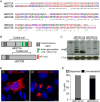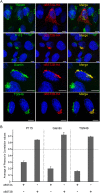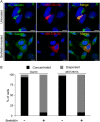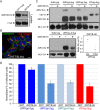The sheep tetherin paralog oBST2B blocks envelope glycoprotein incorporation into nascent retroviral virions
- PMID: 25339764
- PMCID: PMC4301133
- DOI: 10.1128/JVI.02751-14
The sheep tetherin paralog oBST2B blocks envelope glycoprotein incorporation into nascent retroviral virions
Abstract
Bone marrow stromal cell antigen 2 (BST2) is a cellular restriction factor with a broad antiviral activity. In sheep, the BST2 gene is duplicated into two paralogs termed oBST2A and oBST2B. oBST2A impedes viral exit of the Jaagsiekte sheep retroviruses (JSRV), most probably by retaining virions at the cell membrane, similar to the "tethering" mechanism exerted by human BST2. In this study, we provide evidence that unlike oBST2A, oBST2B is limited to the Golgi apparatus and disrupts JSRV envelope (Env) trafficking by sequestering it. In turn, oBST2B leads to a reduction in Env incorporation into viral particles, which ultimately results in the release of virions that are less infectious. Furthermore, the activity of oBST2B does not seem to be restricted to retroviruses, as it also acts on vesicular stomatitis virus glycoproteins. Therefore, we suggest that oBST2B exerts antiviral activity using a mechanism distinct from the classical tethering restriction observed for oBST2A.
Importance: BST2 is a powerful cellular restriction factor against a wide range of enveloped viruses. Sheep possess two paralogs of the BST2 gene called oBST2A and oBST2B. JSRV, the causative agent of a transmissible lung cancer of sheep, is known to be restricted by oBST2A. In this study, we show that unlike oBST2A, oBST2B impairs the normal cellular trafficking of JSRV envelope glycoproteins by sequestering them within the Golgi apparatus. We also show that oBST2B decreases the incorporation of envelope glycoprotein into JSRV viral particles, which in turn reduces virion infectivity. In conclusion, oBST2B exerts a novel antiviral activity that is distinct from those of BST2 proteins of other species.
Copyright © 2015, American Society for Microbiology. All Rights Reserved.
Figures







Similar articles
-
Interplay between ovine bone marrow stromal cell antigen 2/tetherin and endogenous retroviruses.J Virol. 2010 May;84(9):4415-25. doi: 10.1128/JVI.00029-10. Epub 2010 Feb 24. J Virol. 2010. PMID: 20181686 Free PMC article.
-
Feline immunodeficiency virus envelope glycoproteins antagonize tetherin through a distinctive mechanism that requires virion incorporation.J Virol. 2014 Mar;88(6):3255-72. doi: 10.1128/JVI.03814-13. Epub 2014 Jan 3. J Virol. 2014. PMID: 24390322 Free PMC article.
-
A phosphatidylinositol 3-kinase docking site in the cytoplasmic tail of the Jaagsiekte sheep retrovirus transmembrane protein is essential for envelope-induced transformation of NIH 3T3 cells.J Virol. 2001 Nov;75(22):11002-9. doi: 10.1128/JVI.75.22.11002-11009.2001. J Virol. 2001. PMID: 11602740 Free PMC article.
-
Jaagsiekte Sheep Retrovirus (JSRV): from virus to lung cancer in sheep.Vet Res. 2007 Mar-Apr;38(2):211-28. doi: 10.1051/vetres:2006060. Epub 2007 Jan 25. Vet Res. 2007. PMID: 17257570 Review.
-
Oncogenic transformation by the jaagsiekte sheep retrovirus envelope protein.Oncogene. 2007 Feb 8;26(6):789-801. doi: 10.1038/sj.onc.1209850. Epub 2006 Aug 14. Oncogene. 2007. PMID: 16909114 Review.
Cited by
-
CRISPR-Cas-like system in giant viruses: why MIMIVIRE is not likely to be an adaptive immune system.Virol Sin. 2016 Jun;31(3):193-6. doi: 10.1007/s12250-016-3801-x. Virol Sin. 2016. PMID: 27315813 Free PMC article.
-
Unique Evolution of Antiviral Tetherin in Bats.J Virol. 2022 Oct 26;96(20):e0115222. doi: 10.1128/jvi.01152-22. Epub 2022 Sep 29. J Virol. 2022. PMID: 36173189 Free PMC article.
-
Sensitivity to BST-2 restriction correlates with Orthobunyavirus host range.Virology. 2017 Sep;509:121-130. doi: 10.1016/j.virol.2017.06.017. Epub 2017 Jun 17. Virology. 2017. PMID: 28628828 Free PMC article.
-
Prospects in Innate Immune Responses as Potential Control Strategies against Non-Primate Lentiviruses.Viruses. 2018 Aug 17;10(8):435. doi: 10.3390/v10080435. Viruses. 2018. PMID: 30126090 Free PMC article. Review.
-
BST2/Tetherin Overexpression Modulates Morbillivirus Glycoprotein Production to Inhibit Cell-Cell Fusion.Viruses. 2019 Jul 30;11(8):692. doi: 10.3390/v11080692. Viruses. 2019. PMID: 31366072 Free PMC article.
References
-
- Van Damme N, Goff D, Katsura C, Jorgenson RL, Mitchell R, Johnson MC, Stephens EB, Guatelli J. 2008. The interferon-induced protein BST-2 restricts HIV-1 release and is downregulated from the cell surface by the viral Vpu protein. Cell Host Microbe 3:245–252. doi:10.1016/j.chom.2008.03.001. - DOI - PMC - PubMed
Publication types
MeSH terms
Substances
Grants and funding
LinkOut - more resources
Full Text Sources
Other Literature Sources

